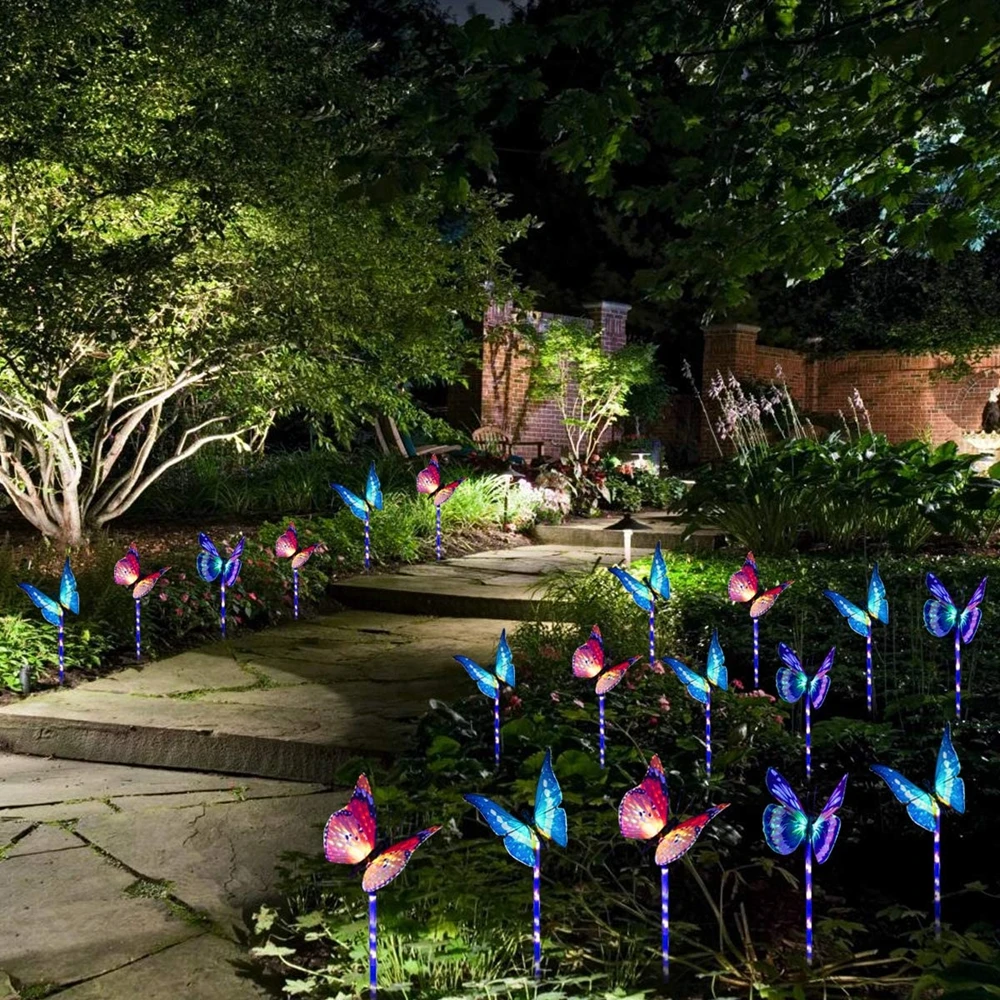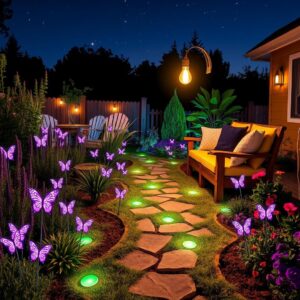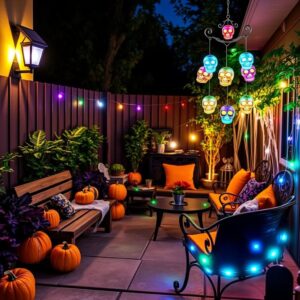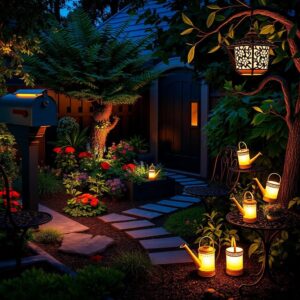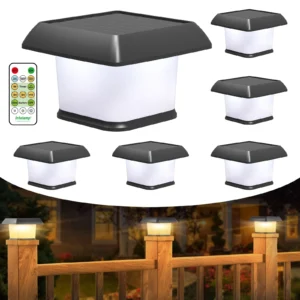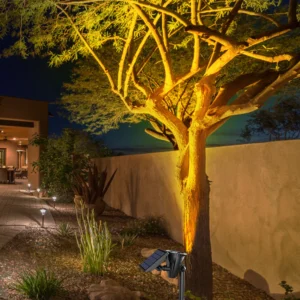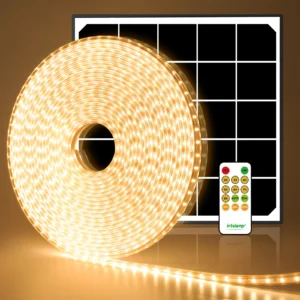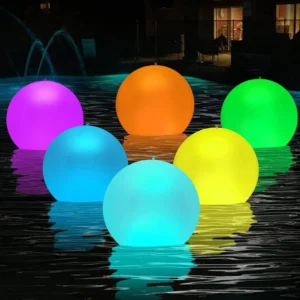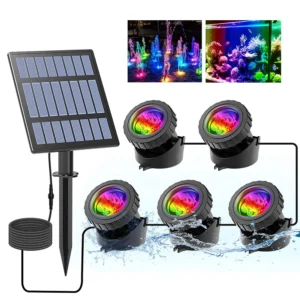Landscape lighting plays a crucial role in enhancing outdoor spaces, creating ambiance, and ensuring safety. By employing effective landscape lighting techniques, homeowners can transform their gardens into inviting environments. This article explores key methods such as uplighting, downlighting, and solar landscape lights, focusing on their benefits and applications.
Types of Landscape Lighting
Solar Inground Lights
Solar inground lights play a vital role in landscape design by creating distinct lighting zones. These fixtures are discreetly installed at ground level, allowing them to blend seamlessly into the landscape. By strategically placing solar inground lights, you can define pathways, highlight specific plants, or illuminate architectural features without cluttering the visual space. Their ability to harness solar energy makes them eco-friendly and cost-effective, requiring minimal maintenance while providing effective illumination. This versatility enables landscape designers to craft layered lighting effects, enhancing the depth and dimension of outdoor areas.
Uplighting Techniques
Uplighting techniques are essential for bringing architectural and natural features to life. Commonly used fixtures include accent lights and well lights, each serving specific applications.
- Accent Lights: These are focused fixtures that direct light upwards to highlight trees, shrubs, and architectural details. By positioning accent lights at the base of larger plants or structures, you can create dramatic shadows and visually striking contrasts. This method enhances the aesthetic appeal of the landscape, making focal points stand out during nighttime.
- Well Lights: Often installed flush with the ground, well lights are perfect for illuminating larger trees or vertical features. Their unobtrusive design allows for a clean look while casting a beautiful glow upward. Well lights can also be used along pathways to enhance safety, providing subtle illumination that guides visitors without overwhelming the space.
Lighting Techniques
Uplighting Techniques
Uplighting is a widely embraced landscape lighting technique that employs fixtures such as accent lights and well lights to create dramatic effects. By directing light upward, this method enhances the visibility of trees, shrubs, and architectural features, transforming the landscape into an enchanting display at night.
Accent Lights
Accent lights are versatile fixtures that can be strategically placed to highlight specific elements in the garden. Whether illuminating a majestic tree or a beautifully sculpted topiary, accent lights draw attention to focal points, creating visual interest. These fixtures can also be adjusted to achieve various angles and intensities, allowing for tailored lighting effects that suit different landscapes. The warm glow from accent lights adds a layer of warmth and sophistication, enhancing the outdoor experience.
Well Lights
Well lights, or in-ground lights, are another effective component of uplighting. These fixtures are installed flush with the ground, making them nearly invisible during the day. When activated, they cast a soft glow upward, accentuating the contours of surrounding plants and structures. Well lights are especially useful for illuminating pathways, entryways, and garden borders, creating a sense of safety while enhancing aesthetics. Their discreet design allows for a clean, unobtrusive look that blends seamlessly into the landscape.
Enhancing Depth and Dimension
Uplighting techniques significantly contribute to the depth and dimension of a garden. By casting shadows and highlights, uplighting creates a layered effect that transforms flat landscapes into three-dimensional spaces. This contrast enhances the visual appeal of foliage and architectural features, making the landscape feel more dynamic and inviting. Additionally, the interplay of light and shadow can evoke different moods, from serene and tranquil to vibrant and lively, allowing homeowners to customize their outdoor environment to suit various occasions.
Front Lighting
Front lighting is a straightforward yet effective method that involves positioning a light fixture directly in front of the object to be illuminated, directing the beam towards it. This technique is particularly effective for smaller plants, shrubs, and decorative features. By illuminating the front of these elements, front lighting enhances their visibility while casting shadows behind, creating a striking contrast that adds depth to the landscape. This method can highlight textures and colors, making plants appear more vibrant at night. Additionally, front lighting can be used to enhance the architectural features of your home or garden, drawing attention to key elements while maintaining a welcoming ambiance.
Shadowing
Shadowing is created when light is directed at an object, causing shadows to fall on adjacent surfaces, such as walls or pathways. This technique can introduce an artistic flair to your landscape, as the interplay of light and shadow creates intriguing visual patterns. However, while shadowing can enhance the overall aesthetic, it also has the potential to cause confusion if not used carefully. Overuse or poor placement of lighting can lead to excessive shadows, making navigation difficult and obscuring important details in the landscape. Therefore, it’s crucial to strike a balance, using shadowing strategically to enhance visual interest without compromising safety or clarity.
Cross Lighting
Cross lighting is an effective technique for illuminating medium to large shrubs and trees. This method involves placing fixtures on either side of the object, directing their beams so they intersect in the middle. Cross lighting offers even illumination, reducing harsh shadows and providing depth and dimension to the landscape. It is particularly useful for creating a three-dimensional effect, allowing viewers to appreciate the full form of the plant or structure. Additionally, this technique is ideal for enhancing visibility from multiple angles, making it a great choice for features that need to be appreciated from different perspectives, such as from the street or an outdoor seating area.
Back Lighting
Back lighting involves positioning a light source behind an object, illuminating it from the rear. This technique often results in silhouette effects, where the object appears dark against a brightly lit background. Silhouette lighting can create dramatic visual displays, especially when used with trees, statues, or other architectural features. This method is effective for enhancing focal points in the landscape, as it draws attention to the shape and outline of the illuminated objects. Back lighting is particularly useful in creating mood and atmosphere, often employed in gardens, patios, and outdoor gathering spaces to evoke a sense of tranquility and beauty.
Wall Wash
Wall wash lighting is a technique designed to create zones of light along walls or vertical surfaces. By positioning fixtures at a distance from the wall and directing light towards it, designers can achieve a soft wash of illumination that enhances the texture and color of the surface. This technique is particularly effective for highlighting architectural details, such as columns, windows, or brickwork, and can transform plain walls into dynamic focal points. Wall washing can also be used to create ambiance in outdoor dining areas or patios, providing a gentle glow that enhances the space without overpowering it.
Mirror Lighting
Mirror lighting takes advantage of reflective surfaces, such as ponds or pools, to create dynamic lighting effects. By positioning fixtures behind or beside a water feature, the light can reflect off the water’s surface, producing mesmerizing visuals that change with the movement of the water. This technique not only enhances the beauty of the landscape but also adds a sense of tranquility and depth. Mirror lighting is particularly effective in gardens and outdoor spaces that feature water elements, as it draws attention to the interplay between light and water, creating a captivating focal point that enhances the overall aesthetic of the area.
Down Lighting
Definition and Applications
Down lighting refers to the placement of light fixtures above a designated area, directing illumination downward toward the ground. This technique is widely used in landscape lighting to create a warm, inviting ambiance while ensuring safety and functionality in outdoor spaces. Common applications of down lighting include path lights, deck lights, and accent lights, which illuminate walkways, patios, and gardens without overwhelming the area with harsh brightness. This method not only highlights architectural features but also enhances the visibility of plants and landscaping elements, making outdoor spaces more enjoyable and accessible after dark. Down lighting can be strategically employed in various settings, from residential backyards to commercial outdoor areas, creating a cozy and welcoming environment.
Moonlight Effects
Moonlight effects in down lighting aim to replicate the soft, gentle illumination of natural moonlight. This technique involves installing fixtures high in trees or on structures, directing their beams through branches to cast delicate shadows on the ground below. By mimicking the diffuse light of a full moon, this method creates a serene atmosphere ideal for gardens, pathways, and outdoor entertaining spaces. The resulting illumination is subtle and enchanting, enhancing the natural beauty of the landscape while providing adequate visibility. Moonlight effects can be particularly effective for outdoor events, where the ambiance plays a crucial role in setting the mood, allowing spaces to feel magical and inviting without overpowering artificial light.
Activity Lighting
Activity lighting focuses on providing adequate illumination for recreational areas, ensuring that outdoor spaces are safe and functional for various activities. This is especially important in locations where families gather for sports, games, or social events, such as basketball courts, pools, and backyards. Properly placed down lighting can eliminate dark spots, reduce shadows, and enhance visibility, making it easier for participants to engage in activities safely. For instance, strategically installed accent lights along pathways can guide users, while brighter fixtures in activity zones can allow for evening games or gatherings. By combining functionality with aesthetic appeal, activity lighting ensures that outdoor recreational areas are both enjoyable and safe for everyone.
Specialty Lighting
Path Lights
Path lights are a quintessential element of landscape lighting, designed to illuminate walkways, driveways, and garden paths. Commonly used in residential and commercial settings, these fixtures enhance safety by guiding users along defined paths and reducing the risk of trips and falls. When installing path lights, it’s crucial to maintain a consistent height and spacing—typically around 6 to 8 feet apart—to create an even wash of light. Placement should also consider the surrounding landscape; fixtures can be integrated into flower beds or alongside shrubs to avoid disrupting the aesthetic. Utilizing low-voltage solar path lights not only minimizes energy consumption but also offers easy installation without the need for extensive wiring, making them a popular choice for eco-conscious homeowners.
Bollard Lights
Bollard lights serve both functional and aesthetic purposes in landscape design. Typically installed along pathways or at property entrances, these fixtures provide low-level illumination that enhances safety while contributing to the overall ambiance. Their design can range from sleek and modern to rustic and traditional, allowing them to complement various architectural styles. Bollard lights can also be used to delineate specific areas, such as outdoor seating or garden beds, while their height makes them visible without obstructing views. For optimal effectiveness, positioning bollard lights strategically to create a cohesive lighting pattern can enhance the visual appeal of outdoor spaces while ensuring clear visibility.
Deck and Step Lights
Deck and step lights are essential for safety in elevated outdoor spaces, providing illumination where visibility is crucial. These fixtures are designed to highlight steps, railings, and deck edges, significantly reducing the risk of accidents in dimly lit areas. When integrating deck lights, it’s vital to consider both safety and design; recessed lights can be installed into the deck or mounted along railings to maintain a clean look. Step lights can also be built into concrete or wooden steps for a seamless appearance. The lighting design should align with the overall landscape aesthetics, ensuring that the fixtures enhance the space without detracting from its natural beauty.
Hardscape Lights
Hardscape lights offer versatility in landscape lighting by providing illumination for patios, walls, and other outdoor features. Designed to integrate seamlessly into hard surfaces like pavers or stone, these fixtures can be installed flush with the ground or embedded into walls to create a sophisticated lighting effect. Hardscape lights are particularly effective for accentuating architectural details and textures, casting dramatic shadows that add depth and character to outdoor spaces. Their installation can be straightforward, often requiring minimal wiring, making them a practical choice for both new constructions and renovations. By strategically placing hardscape lights, designers can highlight focal points and create dynamic outdoor environments that enhance usability and aesthetic appeal.
Adjusting Light Intensity
Importance of Lumen Output
Lumen output is a crucial factor in landscape lighting, as it directly measures the brightness of a light source. Understanding lumens helps designers choose the right fixtures to achieve desired illumination levels without overwhelming the landscape. For example, a fixture with a higher lumen output is suitable for areas that require more visibility, such as pathways or recreational zones, while lower-lumen fixtures can create subtle accents for decorative elements. It’s essential to balance lumens across different fixtures to maintain a cohesive lighting design. Additionally, modern LED technology allows for energy-efficient options that provide more lumens per watt, enabling homeowners to achieve vibrant outdoor spaces while keeping energy costs low. Ultimately, selecting the appropriate lumen output ensures that each area is adequately lit, enhancing safety and ambiance.
Beam Dispersion Effects on Lighting
Beam dispersion refers to how light is spread from a fixture and significantly influences the overall effect of landscape lighting. Fixtures with narrow beam spreads concentrate light in a focused area, making them ideal for highlighting specific features such as trees or architectural details. Conversely, fixtures with wider beam dispersion distribute light over a broader area, creating softer illumination that is perfect for pathways and larger spaces. By understanding the effects of beam dispersion, lighting designers can strategically position fixtures to achieve the desired ambiance and functionality. For example, cross-lighting techniques may benefit from a combination of narrow and wide beam spreads to enhance depth and dimension in a landscape. Adjusting both lumen output and beam dispersion allows for a tailored lighting experience that emphasizes the beauty of outdoor spaces while ensuring safety and usability.
Principles of Light
Indirect Lighting Benefits
Indirect lighting is a fundamental principle in landscape design, focusing on illuminating spaces without exposing the light source directly to viewers. This technique offers several benefits, including enhanced aesthetics and reduced glare. By bouncing light off surfaces such as walls, pathways, or foliage, indirect lighting creates a soft, ambient glow that enhances the natural beauty of the landscape. This approach not only minimizes harsh shadows but also adds depth and dimension to the environment. Additionally, indirect lighting can highlight textures and colors within the landscape, creating a more inviting atmosphere for outdoor living spaces. It is particularly effective for creating zones of light that guide users through the landscape while maintaining a serene ambiance that complements nighttime activities.
Managing Glare and Visibility
Managing glare is crucial for creating comfortable outdoor environments. Glare occurs when bright light sources are visible from viewing angles, leading to discomfort and reduced visibility. To mitigate glare, designers can employ several strategies, such as using fixtures with shielding or positioning lights strategically to direct illumination away from eye levels. For instance, burying well lights or using louvers can help obscure direct views of the light source, enhancing the overall experience of the space. Additionally, adjusting the intensity and beam dispersion of lights can further reduce glare while maintaining adequate visibility for safety. This careful consideration ensures that users can enjoy their outdoor spaces without being distracted or blinded by harsh lighting. Ultimately, managing glare not only enhances comfort but also improves the usability and enjoyment of landscape lighting.
Conclusion
Utilizing effective landscape lighting techniques like uplighting and downlighting can significantly elevate your outdoor space. By carefully selecting and positioning fixtures, homeowners can create stunning visuals, enhance safety, and enjoy their gardens day and night. Consider these methods to transform your landscape into an inviting sanctuary.

